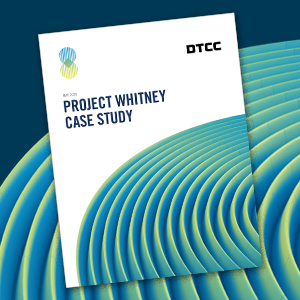Exploring the Value in a Modern Digital Infrastructure for Private Market Securities
Over the past months, DTCC’s Innovation Team has led the exploration and experimentation of digitalization as a viable option to drive the modernization of the capital markets infrastructure.
The results of that research are detailed in a pair of case studies, Project Whitney and Project ION. The studies are the latest efforts by DTCC to examine the potential use of DLT, asset digitalization and other emerging technologies to strengthen post-trade processes and reduce risk and cost for the industry.
Jennifer Peve, Managing Director, Business Innovation at DTCC, sat down with DTCC Connection to discuss Project Whitney. To learn more about Project ION, click here.
Q. What is Project Whitney?
JP: Project Whitney is a prototype designed to explore the value in creating a modern digital infrastructure to support private market assets throughout their lifecycle (e.g., issuance, distribution and secondary transfer). The goal of the prototype is to evaluate, among other things, if current challenges in private markets can be addressed by a digital infrastructure.
Q. Why is DTCC pursuing a solution for the private markets?
JP: Through our research we learned that private markets suffer from certain inefficiencies. For example, currently, many functions are processed manually and the few digital solutions that are available exist in silos.
Today, DTCC provides a standardized trading and reporting platform for the alternatives industry, and Project Whitney complements this service with a solution for private markets. It demonstrates our continued efforts to deliver new capabilities and to advance the markets together, as we have done since our founding.
Q. How does the Project Whitney announcement support DTCC’s overall strategy?
JP: DTCC has been a leader in the digital transformation of financial markets since our founding, and Project Whitney builds on our legacy of leveraging innovative solutions to strengthen post-trade processes. As with the industry, DTCC will not adopt a technology for the technology’s sake; any innovation will need to be thoroughly tested and proven before broad adoption can be considered.

Q. What findings did the DTCC Business Innovation team come across while building the Whitney Prototype?
JP: Given that many security token offerings have been performed on the public Ethereum blockchain, one of our objectives was to determine how the combination of off-chain compliance enforcement of eligible security tokens and an authoritative stock record would bring legitimacy to transactions on a public blockchain.
Through the Whitney Prototype, we can demonstrate a standard and operationally efficient approach to compliance and suitability enforcement, and that the authoritative stock record eliminates the time variances associated with effecting transactions experienced on public blockchains.
Q. What are the next steps for Project Whitney?
JP: DTCC will collaborate with clients and the industry to validate the prototype design concepts, test workflows and integrations and provide feedback. Future phases of Whitney will focus on expanding the prototype to include industry feedback as well as supporting integration with additional DLT platforms.